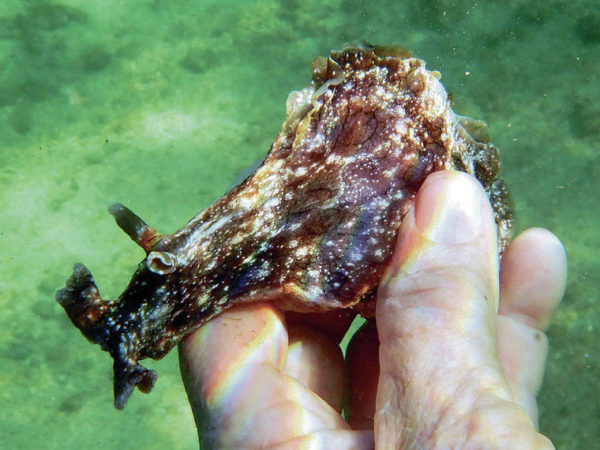Published in the Ocean Watch column, Honolulu Star-Advertiser © Susan Scott
October 12, 2019
During an exhausting week of work and errands, I needed a pick-me-up, my usual being to go snorkeling. Conditions were not ideal. The surf was up, the tradewinds were on and a recent rain squall had clouded the water with runoff. Even so, getting in the ocean is always a mood lifter, especially this year when high air temperatures have been breaking records for months.
The water, too, has been noticeably warmer this summer due to an El Nino current, an abnormal weather pattern caused by Pacific Ocean warming near the equator.
 The two rows of frills on a white-speckled
The two rows of frills on a white-speckled
sea hare’s back line its hidden shell.
©2019 Susan Scott
After months of summer sun, Hawaii’s highest water temperatures occur in September and October, those months averaging 81 degrees off Honolulu. The averages aren’t in yet for this year, but the highest I found on a recent National Oceanic and Atmospheric Administration posting was 83.8 degrees, an increase we swimmers feel as soon as we put our toes in the water.
This week, though, my toes and the rest of me felt pockets of cool water as I made my way to the reef. And as often happens in the ocean, I came across a scene I’ve not seen before: two white-speckled sea hares mating.
Sea hares are large sea slugs named for rabbits because of earlike tentacles that rise from the creature’s head. These, however, would be mutant rabbits, because sea hares have four projections, one pair pointing forward and another pair standing straight up.
Nor are they ears. They’re combined noses and tongues. These sensory structures, called rhinophores (“rhino” means nose in ancient Greek), smell and taste chemicals dissolved in the water. Most sea slugs have these upright organs, guiding them around the reef to find food and members of their own species for mating.
I didn’t say the opposite sex of their own species because sea hares don’t have that bother. They’re hermaphrodites, each individual bearing both male and female sex organs. As a result, any mature white-speckled sea hare that another comes across is a potential mate.
Hawaii hosts at least eight species of sea hares. The white-speckled is one of the larger, growing to 8 inches long, and is one of the more common species found on tropical reef flats worldwide.
Happy to have witnessed the making of more sea hares, I left the mating couple in peace. Three days later, though, circumstances found me snorkeling in the same place, and amazingly, I found two, maybe the same pair, in the same area.
Because they were done mating, I picked one up to admire its lovely pattern and feel the remnant of an under-the-skin shell on its humped back. This is evolutionary evidence of this creature’s relationship to snails with shells.
After snapping a few pictures, I reunited the sea hare with its buddy and felt another stream of cool water pass me. It’s a sign that winter is coming, but in this changing world, what that will bring, only time will tell.
In the meantime I’m staying energized in the heat by snorkeling with sea hares.